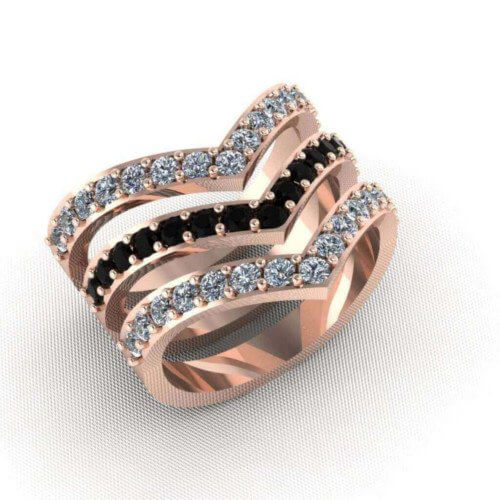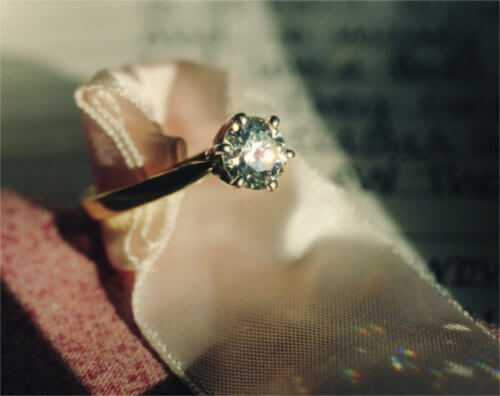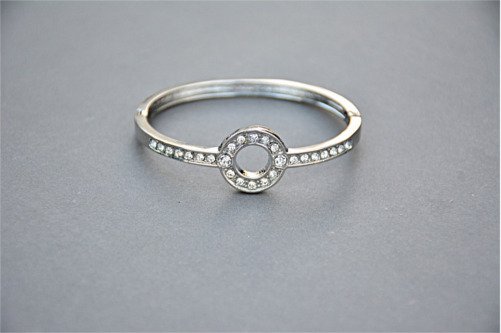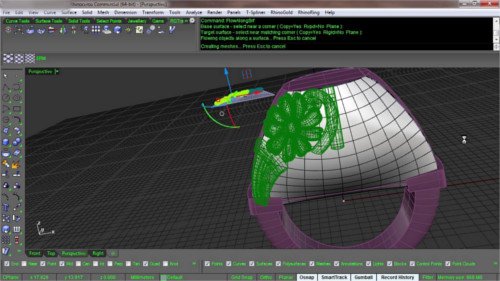
A ring may seem like a simple circle of metal, but in reality, it is so much more complicated. It is important to know all the parts that make up a ring when making jewelry in order for designs to be fabricated properly. Read on to learn about the anatomy of a ring from MKM Jewelry.
The Mounting
The most basic part of the anatomy of a ring is called the mounting. The mounting is the seamless circle of metal that the other parts of the ring extend from. It also includes the shank which is the part of the band on either side of the center stone. The mounting can be made from a variety of metals including gold, sterling silver, bronze, and brass. This base can be plain, textured, or inlaid with small stones.
The Head
For a ring that features set stones, such as a diamond engagement band, the largest, central setting holding the main stone in place is referred to as the head. The head holds the diamond or other gem in place with a number of prongs, the quantity of which will depend on the size and cut of the stone. The head has a peg on the bottom that secures it to the mounting.
The Gallery
When speaking in terms of ring anatomy, the gallery of the ring is generally a hollow area on the underside of the ring that fits over the top of a finger It allows more room for fingers or gemstones. Large, domed rings are the ones that benefit most from having a gallery.
The Prongs

In basic ring anatomy, the prongs are short metal rods that reach from the mounting up and around the stone. The top part of the prongs, called the tips, wrap over the top edge of the diamond to keep the gem in place.
Prong Count
A four prong head ensures most of the stone is visible from the side and allows more light hit the gem, making the stone sparkle more. However, a four prong head can also make diamonds look more square-shaped, and are less secure than six-prong heads. A six prong head adds extra security, because if a prong is damaged, the stone will remain in place with the other five prongs.
Types of Prongs
Prongs can be both functional and decorative. V-tipped prongs are great for accenting and protecting the pointed tips of princess cut, pear shaped, and Marquise cut gemstones. Tulip heads feature ornamental cutouts that can add an art deco edge to an engagement ring. A buttercup head is an ornate head design that features gorgeous curved prongs to showcase the cut stone.
Damage and Repair
In terms of the anatomy of the ring, prongs are the most easily damaged part of the ring, as they are frequently bumped and rubbed, leading to damage to the ring. For a ring that faces daily wear, such as a wedding ring, jewelers recommend the prongs be replaced every 7-10 years in order to keep the ring in prime condition.
The Shoulder
Most rings with a head will also have a shoulder, which is the top two sides of the ring. The shoulder rises up above the mounting to protect the setting of the head. It can also be quite decorative; featuring pave set stones, channels or other adornments. When working in CAD for jewelry design, tweaking a ring can be as easy as copying a file and using the digital tools to widen the band, change the shape of the shoulders, or adjust the scale.
The Gemstone
The next step in mastering the anatomy of the ring is learning the different types of gemstone cuts. The shape of the stone is dependent on the way it is cut and faceted. One of the key factors in the cut of a gem is the depth of the cut. Stones that are cut too shallow or too deep will refract light less well than gems cut to the ideal depth, resulting in less sparkle and shine.
The Table
In regards to the anatomy of the stone itself, the flat plane at the top is referred to as the table. The table is cut into an octagonal shape and allows you to see the brilliance at the core of the diamond.
The Girdle, Crown, and Culet
The diamond is split into a top and bottom section by the girdle, which marks the change in cut direction. The top part of the diamond above the girdle is referred to as the crown. The crown should be cut at an angle of 33.7-35.8% in order to bounce the light throughout the diamond. The lower part below the girdle is called the pavilion. The tip at the base of the diamond is known as the culet.
Diamond Cuts
The most common diamond cut is the round brilliant cut, but other popular styles include the radiant cut (which is cut into long rectangular shape), the cushion cut (which looks like a rounded square), the oval cut, and the emerald cut. Pear shape cut diamonds, also referred to as tear drop cuts, and square princess cut diamonds are also used in many ring designs.
The Embellishments

In the anatomy of the ring, big, complex, multi faceted gems are generally used for the head, acting as a majestic glittery centerpiece in the design. For accent and trim work, designers tend to use smaller stones, such as single cut diamonds, or small rectangular cut stones known as baguettes, in order to add some additional sparkle to the overall design. Because single cut diamonds and straight baguettes have fewer facets, they lack the clarity and depth of more complex stones, and are mainly used as accents.
Setting Styles
Tiny accents stones can be used in numerous ways in jewelry design. One of the most dazzling uses is a pave setting, where tiny gems are set side by side to create a sparkling field of cut stones. Jewelry designers can also flush set diamonds by drilling small holes into the ring and snapping the diamonds in place so that the stones lay flat into the band of the ring.
Designers looking for a smooth, seamless look might consider bezel setting their gemstones. In a bezel setting, the stone is set within a rim of metal that wraps around the top edge of the diamond. A bezel setting gives a clean, seamless look, and is more secure than a traditional prong setting. However, because the sides and outer edge of the stone is covered in a bezel setting, the gemstone may appear smaller than when it is prong set.
The Hallmark
To complete our glossary of ring anatomy, we end with the hallmark. A hallmark is a mark or series of marks made on the inside of the mounting that identifies and certifies the content of precious and semi-precious metals. Some of the more commonly used hallmarks include 925 to indicate sterling silver, 585 or 14K and 750 or 18K for gold, and 950 for platinum.

Jewelry designers looking to manufacturing a larger line of rings may want to consider using CAD jewelry design software to design their wares. CAD for jewelry design allows jewelers to create beautiful, intricate pieces, and work at a level of detail impossible to achieve with traditional techniques. The CAD models can then be 3D printed into wax for use in the lost wax casting method.
Some popular CAD programs for jewelry design include JWEEL, Autodesk, and Rhino. At MKM Jewelry, we’re experts with all of these programs and can help you design your jewelry from start to finish!
Work with Us!
At MKM jewelry, we can bring your CAD jewelry designs to life. We fabricate a variety of jewelry out of high quality materials such as gold, silver, bronze, and brass. Our manufacturing facility can also
set gemstones,
engrave, enamel, and
finish your pieces.
As the premiere jewelry fabricator in the greater Los Angeles area, we help the top jewelry designers in Southern California turn their CAD jewelry designs into heirloom quality pieces.
Reach out to us today to learn more!






Leave a Comment